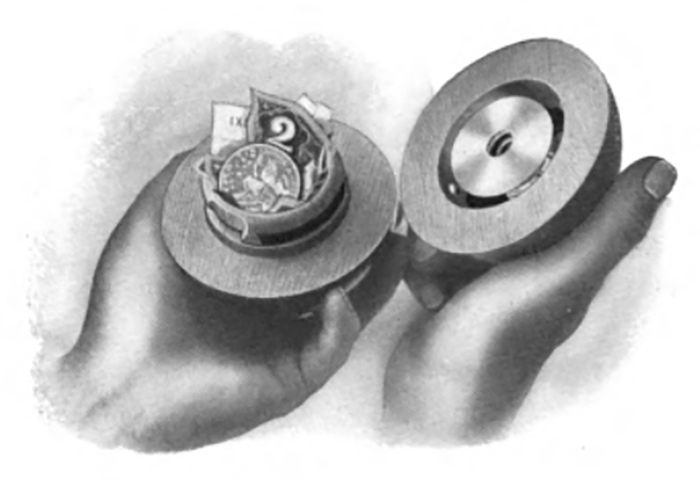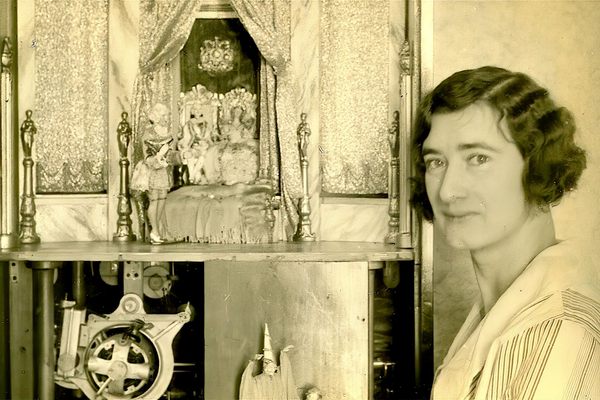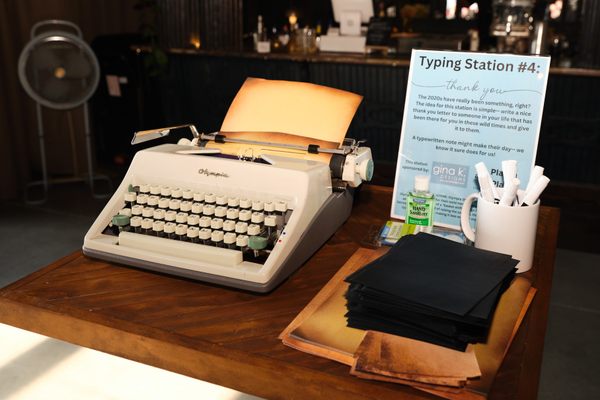The Rise and Fall of the Cash Railway
 Inside the Lamson ball, from a 1912 Lamson catalogue. (Image: Tony Wolf)
Inside the Lamson ball, from a 1912 Lamson catalogue. (Image: Tony Wolf)
During the late 19th century retail boom, shop owners were plagued by robberies at sales counters and rampant employee pilfering. As the average person buying food or fabric did not want to wait many minutes to pay or receive change, the owners needed to find secure but convenient ways of moving money within their establishments.
Their solution was the “cash railway,” a Rube Goldberg-like contraption of overhead wires, springs, turnbuckles and rails that could zipline money from sales clerks to cashiers and back again.
The earliest method of transporting cash within large stores was to employ children as runners. Clerks would ring bells or call out “Cash!” to summon the “cash boys” and “cash girls,” who would race over to the counter, retrieve the customer’s money and then run to the cashier’s station and back again, bearing the correct change. Apart from the fluster and occasional danger of having young children dodging between customers and display racks as they raced through the aisles, some progressive social critics also complained about the cash runners’ long hours and poor working conditions.
William Stickney Lamson, a cloth retailer in Lowell, Massachusetts, was among the first to attempt to streamline the process by automation. Starting in the late 1870s, he experimented by having his salespeople bundle money in handkerchiefs and simply throw the bundles from one to another until they reached the cashier’s station.
Dissatisfied with this efficient but undignified method, Lamson then contrived a system of securing cash inside hollow wooden balls, which could be rolled along sloping wooden rails affixed behind his store’s shelves. His customers enjoyed the convenience and novelty of his invention so much that other retailers soon caught on, leading Lamson to start a new business producing cash-ball railways. In 1882, his new Cash Carrier Company was incorporated in Boston.

Sales counter, with rails visible overhead. (Photo: Tony Wolf)
The cash-ball system worked reasonably well, but the rails were intrusive and the interior layout of some stores did not allow certain counters or departments to be connected by inclined tracks. The ingenious Lamson then hit upon the concept of the “aerial railway” and set about tinkering with a gondola-like design, which became known as the wire-line or cable-carrier.
By the late 1880s, sales staff could secure cash inside a small wooden jar or canister, suspended by wheels from a taut wire that ran overhead from the sales desk to the cashier’s station, which was typically a cage-like booth situated in the center of the store. By tugging firmly on a spring-loaded cord or lever known as the “propulsion,” the canister would be catapulted along the wire, reaching its destination in mere seconds.
The cashier could then “return fire” with change and a receipt. Cashiers who worked in booths on levels above the sales floor could simply release the canister and let gravity return it to the appropriate counter.
On especially busy days, cashiers required the dexterity of jugglers to keep pace with the rapid shuttling of canisters from different departments. They also required steady nerves, as high-spirited sales clerks would occasionally try to prank them by placing live mice or dead spiders inside the canisters. In-store gossip and romances could be covertly conducted by secret messages passed back and forth via the cash-carrier wires.
 The parcel mechanism. (Image: Tony Wolf)
The parcel mechanism. (Image: Tony Wolf)
William Lamson’s Cash Carrier Company was global by the mid-1890s, supplying retailers throughout Great Britain and the British Commonwealth as well as the U.S. and Canada. Inevitably, he also had competitors, as other inventors took out their own patents and vied to succeed in the burgeoning cash-carrier industry.
Keeping up with new demands, cable-carrier systems also became larger, more complex and more robust. In one very popular innovation, an electric motor powered a series of endless cables running between light metal tracks.
According to a 1906 manufacturer’s brochure, “the rapidly running and noiseless cable engages small steel boxes and slides them swiftly along their tracks, up, down, around corners, and through partitions, floors or walls to their destination, where they are automatically and consecutively switched off and arrested at the hand of the clerk or cashier.”
Other designs, known as Parcel Carriers, featured sturdy baskets that could be raised and lowered from the overhead wires by pulleys. Customers could now take their small items to a sales desk and watch them shoot off on the aerial railway, only to return, fully wrapped, a few minutes later. Some large department stores also used these systems to transport items from the sales floor to the shipping department, where they would be packaged and sent off by courier to the customer’s home.
 The cashier booth. (Photo: Tony Wolf)
The cashier booth. (Photo: Tony Wolf)
Manufactured and sold under various names–the Lamson Rapid Wire, the Dart Cash Carrier, and the Baldwin Flyer–these railways became ubiquitous features of early 20th century retail store design. The most elaborate systems resembled fantastical theme park thrill-rides as they sent money and goods zipping across open space, careening around corners and zooming up and down inclined wires.
As cash railways became part of the zeitgeist, playwrights and novelists often used them as shorthand to set the scene in writing about large stores: “Through all this confusion was woven a radial system of wires, converging at the cashier’s window. Along these airy tracks the carriers sped, to stop with a snap above the cashier’s head, waiting for her to make change and shoot them back,” Gelett Burgess wrote in his 1906 collection of short stories, A Little Sister of Destiny.
Because the railways were also fun to use and to watch in action, they were frequently featured in silent slapstick comedies, like Charlie Chaplin’s The Floorwalker, from 1916, and The Butcher Boy, starring “Fatty” Arbuckle and Buster Keaton, the following year.
Not even the most talented comedians, however, could contrive to match the real-life chaos that occurred when dogs found their way into stores with busy cash railways. The following story from a 1903 New Zealand newspaper is typical:
“A young lady went into a large dry goods store on a shopping expedition, having for a companion a big handsome dog. He was a pointer and the manner in which he trotted sedately along and kept out of everybody’s way showed that he was as intelligent as handsome.
The young lady having made her purchase, the shop-girl put the check and the money in a wooden ball and sent it along the ‘cash railway.’ At the first ‘whiz’ the dog pricked up his ears, and the next instant he started after the ball as if he were morally sure it was some new kind of bird. Past the crowds of Christmas buyers, in and out and between hundreds of people, the pointer dashed until the ball disappeared from view.
Then he looked puzzled and then humiliated, and was coming back to his indignant mistress when the ball came whizzing on its return trip. This time the dog expressed his feelings by short yelps as he flew after his game, and this time he took the short route along the counter and fetched up in front of the shop girl, leaving behind him a trail of dismayed shoppers. Then the ball was given to him to investigate, and a more disappointed dog was never seen.”

A cash ball system at the Up-To-Date store, a museum in New South Wales, Australia. (Photo: Bidgee/WikiCommons CC BY-SA 3.0)
For generations of children born before the 1950s, watching cash and small goods zipping around overhead was a much-anticipated highlight of shopping expeditions. Some stores even occasionally allowed older children to pull the propulsion cord, which became something of a right of passage. Kids also constructed their own cash railways at home, using Meccano and Erector sets, and some were lucky enough to receive functional toy cash carriers as presents.
Inevitably, however, cash railway systems became outmoded by newer innovations. Automatic counter registers took care of most security concerns and, eventually, pneumatic tubes offered an even faster and more streamlined way to transport small goods around large stores.
Dylan Thomas aptly expressed the nostalgic romance of the cash railway in his 1954 radio drama Under Milk Wood: “I am a draper mad with love. I love you more than all the flannelette and calico, candlewick, dimity, crash and merino, tussore, cretonne, crepon, muslin, poplin, ticking and twill in the whole Cloth Hall of the world. I have come to take you away to my Emporium on the hill, where the change hums on wires.”
Today, most functional cash carriers have been relegated to museums. There are, however, still a few stores that proudly maintain their antique systems, going so far as to have replacement parts custom-made. When asked why his 117-year old Indianapolis store, Stout’s Shoes, held onto its Baldwin Flyer basket system, co-owner Brad Stout replied:
“Because if you sit in that office up there, every single day you will see an adult come in with a child and point and say, ‘Look! That’s what I was talking about!’”










Follow us on Twitter to get the latest on the world's hidden wonders.
Like us on Facebook to get the latest on the world's hidden wonders.
Follow us on Twitter Like us on Facebook